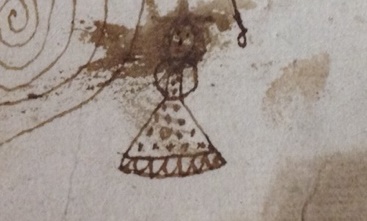
July 20, 2015, by Kathryn Steenson
Doodles and Divinity
This is a guest post by Ashleigh Fowler, student from the School of English.
Since November 2014 I have been cataloguing the Ashby de la Zouch Parish Library as one of three student volunteers chosen to work on the collection. The library is, unsurprisingly, largely theological texts with a large helping of classical Greek literature, but despite this (or maybe partly because of this, depending on your own tastes) manages to be completely fascinating. I officially stopped working on it at the end of this academic year, but still can’t help occasionally Googling things related to the collection that pop into my mind.
The library itself is a parochial library with most of the books dating from the 17th and 18th century, although there are several earlier editions dating as far back as the late 15th century and quite a few later additions up to the very early 20th century included alongside. A number of donors have names listed within the books – my personal favourite being the excellently-named Marmaduke Vavasour, vicar of the church from 1834-1875, but the bulk of the collection was donated by Thomas Bate (b.1675 – d.1727) whose signature can be found in hundreds of title pages across the library.
Peter Cowper, vicar 1729 – 1783, also donated a number of books to the library. Not quite so many as Thomas Bate, but enough that his signature also has become a very familiar sight after working on the collection for a few months. His is not quite as clearly read as Thomas Bate’s however, which led to several weeks wondering who “Plowper”could be.
My work on the library has mostly included cataloguing, with very, very minor conservation work in the form of dusting and tying together when needed. The library spent a while in Loughborough Technical College, and was then moved to Loughborough UL and it is possible in one of those institutions the catalogue that came with the collection was created. The existence of that catalogue has meant that most of the work I, and the other 2 volunteers, have been doing is cross checking what we have found against what is listed in this catalogue and recording any differences between the two, as well as noting the states of all books and making sure they’re nicely dust free and secure.
But a simple sounding task isn’t necessarily always a simple task. The number of books with missing or obscured title pages means it is often necessary to browse through the books with microscopic precision, and this slow pouring over the books led to my favourite discovery of the project: doodles.
And not just one or two,
The collection is teeming with them. In many cases it is just a swirl, or what appears to be someone testing ink, but there are a number of clearly pictorial doodles and some longer hand written notes as well. Even though it would probably be impossible now to trace the doodles back to the doodlers, I think the humanity it adds to the collection is amazing. It would be easy to look at a book in a parochial library with a shred of boredom and expect it to be quite dry, but realising that 300 years ago someone was looking at the same book and possibly thinking the same thing judging by the volume of drawings suddenly makes it far more interesting and before you know it you’ve spent 25 minutes staring at a book of valuations for ecclesiastical properties thinking this is the best thing you’ve seen all year.
And some almost become a little spooky because that was someone’s hand. A very tiny hand too.
Some give a definite flavour of the time they are from. The book this one was found in dated to the 1670s, and looking at the facial hair I would not be surprised if the doodle did as well.
Of course the content of the books is, in many cases, more interesting than would be expected possibly and a 17th century theological work does not necessarily mean dry but my favourites from the collection have been those where an echo of the readers of the past has been left behind, whatever the subject of the book. All I can hope is that someone 300 years from now finds my bored doodles in text books equally as fascinating.
The Ashby Parish Library catalogue is not yet available online, but for more information about Manuscripts and Special Collections please visit the website or follow us on Twitter @mssUniNott.

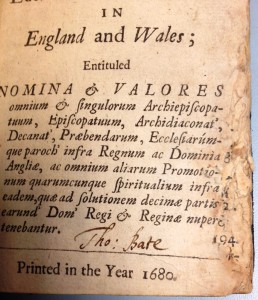


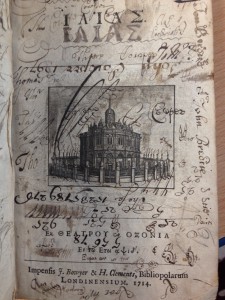
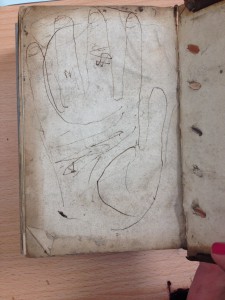
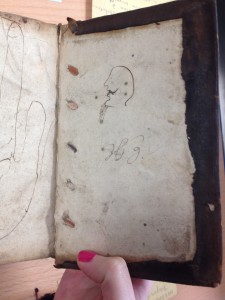
Dear Ashleigh , The Special Collections Dept referred me to your entertaining blog after
showing me a selection of the more robust volumes from the Ashby Bate Library. Rev Thomas
Bate was the elder brother of my 6 x Great-Grandmother Elizabeth Palmer(nee Bate). She
married an anti-Jacobite secret policeman in the time of Queen Anne. Rev Bate became chaplain at Calke Abbey and is impersonated by an actor during the 18th-century ‘Calke Alive’
re-enactment days. There is a 1702 ‘Selfie’ of him on a blank page of ‘Jansons Philanox’ –
either a self-portrait or one by a friend. He was a step-cousin of Sir Isaac Newton.